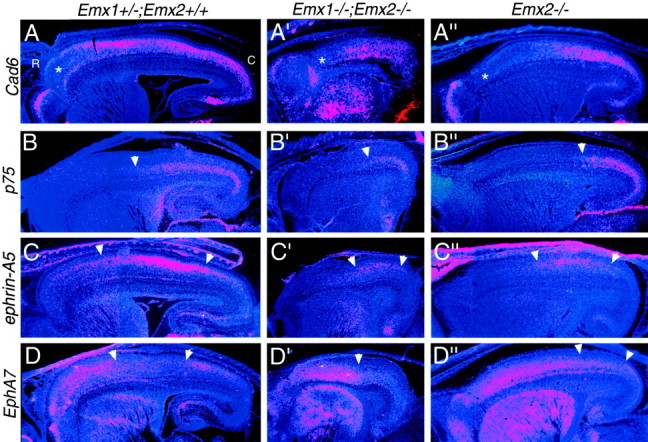Fig. 9.

The relative positioning of expression domains of gene markers in Emx1; Emx2 double mutant neocortex resembles that in Emx2 single mutant neocortex. Shown are in situ hybridizations on sagittal sections through the forebrain of E18.5 (A–D) wild-type (i.e.,Emx1+/−; Emx2 +/+) (A′–D′) Emx double mutant (Emx1−/−; Emx2−/−), and (A′′–D′′) Emx2 single mutant (Emx2−/−) mice using S35-labeled riboprobes for Cad6,p75, ephrin-A5, or EphA7and later counterstained with bisbenzimide. Note that the neocortex of the Emx double mutant is reduced to approximately half of the wild-type area. Sections are taken from similar medial–lateral positions. Each panel is a montage of single-exposure photos using dark-field illumination and a red filter to view the silver grains and UV fluorescence to view the counterstain. Theasterisks in A–A′′ mark a domain of low Cad6 expression normally characteristic of far rostral neocortex. This domain of low expression expands and shifts caudally in Emx double mutants and Emx2 mutants.p75 is expressed in the deep layers in roughly the caudal half of the wild-type neocortex (B); this expression domain constricts caudally in Emx double mutants andEmx2 mutants (B′, B′′). The arrowheads mark the rostral limit of expression. In wild-type mice, ephrin-A5 has high expression centered on the somatosensory area (A, B), whereasEphA7 has low expression centered on the somatosensory area (C, D). These domains shift caudally in Emx double mutants and Emx2 mutants (C′, D′, C′′,D′′). Arrowheads mark the domains of highephrin-A5 or low EphA7 expression. See Results for details. C, Caudal; R, rostral.
